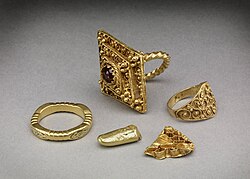Portal:Anglo-Saxon England
Anglo-Saxon England
Anglo-Saxon England or Early Medieval England, existing from the 5th to the 11th centuries from soon after the end of Roman Britain until the Norman Conquest in 1066, consisted of various Anglo-Saxon kingdoms until 927, when it was united as the Kingdom of England by King Æthelstan (r. 927–939). It became part of the short-lived North Sea Empire of Cnut, a personal union between England, Denmark and Norway in the 11th century. The Anglo-Saxons migrated to Britain (Pretanī, Prydain) from mainland northwestern Europe after the Roman Empire withdrawal from the isle at the beginning of the 5th century. Anglo-Saxon history thus begins during the period of sub-Roman Britain following the end of Roman control, and traces the establishment of Anglo-Saxon kingdoms in the 5th and 6th centuries (conventionally identified as seven main kingdoms: Northumbria, Mercia, East Anglia, Essex, Kent, Sussex, and Wessex); their Christianisation during the 7th century; the threat of Viking invasions and Danish settlers; the gradual unification of England under the Wessex hegemony during the 9th and 10th centuries; and ending with the Norman Conquest of England by William the Conqueror in 1066. The Normans persecuted the Anglo-Saxons and overthrew their ruling class to substitute their own leaders to oversee and rule England. However, Anglo-Saxon identity survived beyond the Norman Conquest, came to be known as Englishry under Norman rule, and through social and cultural integration with Romano-British Celts, Danes and Normans became the modern English people. (Full article...) Selected articleThe members of the Gregorian mission were Italian monks and priests sent by Pope Gregory the Great to Britain in the late 6th and early 7th centuries to convert and Christianize the Anglo-Saxons from their native Anglo-Saxon paganism. The first group consisted of about 40 monks and priests, some of whom had been monks in Gregory's own monastery in Rome. After a long trip, during which they almost gave up and returned to Rome, they arrived in the Anglo-Saxon kingdom of Kent in 597. Gregory sent a second group of missionaries in 601 as reinforcements, along with books and relics for the newly founded churches. From Kent, the missionaries spread to the East Anglian kingdom and to the north of Britain, but after King Æthelberht of Kent's death, the mission was mostly confined to Kent. Another mission was sent to the kingdom of Northumbria when Æthelberht's daughter married King Edwin of Northumbria around 625. After Edwin's death in 633, a pagan backlash against Christianization occurred, and the mission was again confined to Kent; most of the missionaries fled Northumbria because they feared the pagans who returned to power after Edwin's death. (more...) Did you know?
SubcategoriesSelected image Hoard of Anglo-Saxon rings found at Leeds, West Yorkshire. Selected biography
Cnut the Great (Old Norse: Knútr inn ríki; c. 985 or 995 – 12 November 1035), also known as Canute, was a king of Denmark, England, Norway and parts of Sweden. After the death of his heirs within a decade of his own and the Norman conquest of England in 1066, his legacy was largely lost to history. Cnut was of Danish and Slavic descent. His father was Sweyn Forkbeard, King of Denmark and his mother was the daughter of the first duke of the Polans, Mieszko I. Cnut won the throne of England in 1016 in the wake of centuries of Viking activity in northwestern Europe. His accession to the Danish throne in 1018 brought the crowns of England and Denmark together. Cnut held this power-base together by uniting Danes and Englishmen under cultural bonds of wealth and custom, rather than sheer brutality. After a decade of conflict with opponents in Scandinavia, Cnut claimed the crown of Norway in Trondheim in 1028. He had coins struck which called him king there, but there is no narrative record of his occupation. Cnut's possession of England's dioceses and the continental Diocese of Denmark was a source of great leverage within the Church, gaining notable concessions from Pope Benedict VIII, and his successor John XIX, such as one on the price of the pallium of his bishops. Cnut also gained concessions on the tolls his people had to pay on the way to Rome from other magnates of medieval Christendom, at the coronation of the Holy Roman Emperor. (more...) Things you can do
Featured articles and lists
Related portalsWikiProjects
Associated WikimediaThe following Wikimedia Foundation sister projects provide more on this subject:
| |||||||||||||||||||














